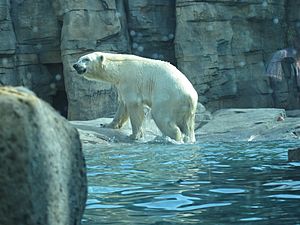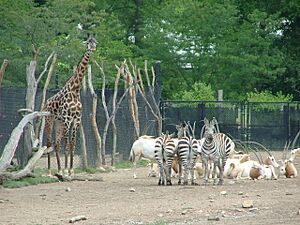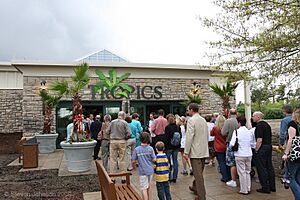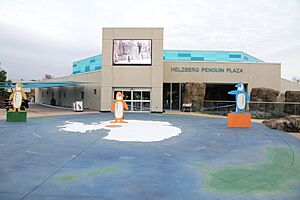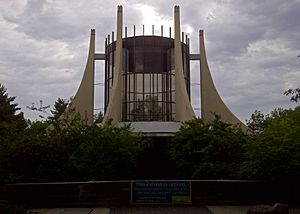- This page was last modified on 9 August 2025, at 07:21. Suggest an edit.
Kansas City Zoo & Aquarium facts for kids
 |
|
| Date opened | December 13, 1909 |
|---|---|
| Location | Swope Park Kansas City, Missouri, United States |
| Land area | 202 acres (82 ha) |
| Coordinates | 39°0′25″N 94°31′45″W / 39.00694°N 94.52917°W |
| No. of animals | 1,700+ (Zoo) and 8,000+ (Aquarium) |
| Annual visitors | 1+ million |
| Memberships | AZA |
The Kansas City Zoo & Aquarium is a huge home for animals, covering 202-acre (82 ha) in Kansas City, Missouri. It first opened its doors in 1909. More than a million people visit every year to see its amazing collection of nearly 1,700 animals in the zoo and about 8,000 animals in the aquarium! The zoo is a proud member of the Association of Zoos and Aquariums (AZA), which means it meets high standards for animal care.
Contents
Zoo History and Growth
Planning for the zoo began in 1907, and it officially opened on December 13, 1909. For its first 40 years, the zoo grew slowly. It added exhibits like the Bear Grotto in 1912. Things picked up in the 1940s with a monkey island and a children's zoo.
The 1950s brought exciting additions like a sea lion pool, the African Veldt, a giraffe house, and flamingos. In the 1960s, an otter pool, an elephant house, and the Great Ape House were built. The early 1970s saw a dairy barn, the Great Catwalk, and gibbon islands.
A big change happened in 1991 when the zoo expanded to its current 202 acres (82 ha) size. New sections like Australia (1993), International Festival (1994), and Africa (1995) were added. The Africa section was very popular, drawing about 40,000 visitors in its first two days!
The zoo also built the Sprint IMAX Theater, which was the first IMAX theater in a zoo. These improvements led to record attendance in 1998. The zoo grew from a small 60-acre space to a large, 202-acre home for over 1,300 animals. In 2002, the Orangutan Primadome opened. This was part of a new way the zoo was managed, changing from city-run to a partnership with Friends of the Zoo (FOTZ).
A 20-year plan guides the zoo's future. The Discovery Barn opened in 2006, along with a shortcut path to Africa. In 2006, the Kansas City Zoo was chosen to be a special breeding place for African elephants and baboons. An endangered species carousel was added to KidZone in 2007. New admission gates opened in May 2008, featuring new parking and animal exhibits.
Many parts of the zoo were updated starting in late 2005. The Discovery Barn, which used to be the Red Barn, opened in 2006. It has fun exhibits and slides for kids. Outside, there's a Peek-a-Boo Tree with a slide. The Promenade, a wide path to the African elephants, also opened in 2006, making it faster to reach Africa.
The new entrance gates opened in May 2008, with an educational center and exhibits for North American river otters and trumpeter swans. In early 2009, the Tropics House opened. The polar bear exhibit opened in August 2010. In October 2013, the Helzberg Penguin Plaza opened, thanks to fundraising and a special sales tax. The Sobela Ocean Aquarium, which took over 10 years to plan, opened to the public in 2023.
Exploring the Zoo's Exhibits
The Kansas City Zoo covers 202 acres (82 ha) and is home to more than 1,300 animals. It is located in Swope Park, one of the largest city parks in the United States. The zoo is divided into five main areas: Africa, Australia, Tiger Trail, KidZone, and The Valley.
Front Entry Plaza
The main entrance area has admission gates, restrooms, a gift shop, and food options. In 2010, polar bears returned to the zoo near the North American river otter and trumpeter swan pool. This area also has an educational center and stops for the zebra tram and train.
Polar Bear Passage
This exciting exhibit opened on August 8, 2010. It features a huge 140,000 US gallons (530,000 L) pool with a waterfall. Visitors can view the polar bears from many indoor and outdoor spots through thick glass windows. In early 2013, a female polar bear named Berlin joined Nikita, hoping they would have cubs. Nikita later moved to the North Carolina Zoo in late 2015 for breeding. In late 2020, a new male polar bear named Nuniq arrived.
Africa Section
The Africa section is divided into five parts: Botswana, Kenya, Tanzania, the Congolese Rainforest, and Uganda. You can find snack bars, the Rafiki Restaurant, and the Equator gift shop here. The Nanyuki Market has a small aviary with masked lovebirds and white-cheeked turacos. There's also a zebra tram station and a boat house. Tanzania has a pier for a boat ride that takes you across Africa.
Botswana
Botswana is home to nine African bush elephants (eight females, one male) in a 4.5 acres (1.8 ha) exhibit. The elephants sometimes create paintings and do demonstrations on weekends. The elephant walk also features a flamingo pool with Chilean flamingos, black-necked swans, and a Pink-backed Pelican. The Promenade path leads guests directly into Botswana.
A male African elephant named Tamani joined the zoo in October 2015. In October 2023, Christie and Zuri, a mother-daughter elephant duo, moved into this habitat.
Here are the nine elephants at the zoo and where they came from:
- Christi (born 1986, wild-born in Africa), arrived from Hogle Zoo in October 2023.
- Lady (born 1968, wild-born in Africa), arrived from Kings Island in July 1994.
- Lea (born 1978, wild-born in Zimbabwe), arrived from the wild in September 1982.
- Lois (born 1978, wild-born in Zimbabwe), arrived from the wild in September 1982.
- Megan (born 1978, wild-born in Kruger National Park, South Africa), arrived from Kings Island in July 1994.
- Tamani (born 2005, at Lowry Park Zoo), arrived from Birmingham Zoo in October 2015.
- Tattoo (born 1978, wild-born in Africa), arrived from Riverbanks Zoo in May 1995.
- Zoe (born 1984, wild-born in Africa), arrived from Cameron Park Zoo in October 2007.
- Zuri (born 2009, at Hogle Zoo), arrived from Hogle Zoo in October 2023.
Kenya
Kenya features cheetahs with a special observation building. You can also see warthogs and a deck with a view of animals like springbok, lesser kudu, common eland, scimitar-horned oryx, and gray crowned cranes roaming an African plain. Saddle-billed storks and Southern ground hornbills live in wetland exhibits.
In the boma area, which looks like a Kenyan village, you'll find lappet-faced vultures, white-necked ravens, Aldabra tortoises, bateleur eagles, red-flanked duikers, and blue duikers. The walk-through Scrubland Aviary is home to many bird species, including white-cheeked turacos and lilac-breasted rollers. There are also side exhibits for red ruffed lemurs and silvery-cheeked hornbills.
Tanzania
Tanzania has an African lion exhibit with nine lions. You can see them from a climate-controlled building or a covered deck. Smaller exhibits that look like rocky hills, called kopjes, house animals like servals, bushbabys, caracals, black-footed cats, rock hyraxes, and bat-eared foxes.
A log bridge leads to the eastern black rhinoceros exhibit and a large, 3 acres (1.2 ha) home for chimpanzees. The chimpanzee building lets visitors watch a group of 12 chimps play and learn about them in a connected classroom. This part of the African plains also features Masai giraffes, Grant's zebras, gray crowned cranes, and ostriches. Nearby are kori bustards, secretary birds, leopard tortoises, West African dwarf crocodiles, and a hippo pool.
Uganda
The Uganda section has a small outdoor theater stage (Ruwenzori Theatre). It's home to spacious enclosures for African wild dogs and a group of Guinea baboons, which are next to each other. There's also a campsite in the woods that you can reserve for special events.
The Congolese Rainforest
The Congolese Rainforest is located across a historic swinging bridge from Kenya. Here you'll find exhibits for red-capped mangabeys and black mangabeys. Amur leopards are featured in an exhibit with an overhead area that visitors walk under. A raised pathway goes through exhibits with bongos, gray crowned cranes, red river hogs, and yellow-backed duikers, all nestled in the dense forest. You can see a single male western lowland gorilla and a separate breeding group of gorillas from a lookout building and a renovated shelter, offering close-up views through glass.
Australia Section
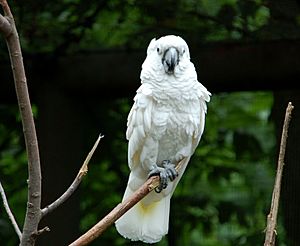
A White cockatoo in the Woodland Aviary.
Australia is in the northern part of the zoo. Here, you'll find a large field where red kangaroos roam freely. There's a walk-through Woodland Aviary with many bird species like black swans, tawny frogmouths, and white cockatoos. Near the aviary exit is an emu exhibit. You can also see parma wallabys, Bennett's wallabys, dingos, and Matschie's tree kangaroos.
A replica of an Australian sheep farm includes a farmer's home, a building with animal hides, spotted pythons, green tree pythons, laughing kookaburras, and a hands-on sheep pen. An exhibit with dromedary camels is just past the sheep farm. Overlooking the kangaroo field is a train station and snack bar. The last exhibit in this loop is an indoor area for Australian snakes.
In 2016, the zoo welcomed a pair of koalas as a special attraction.
Tiger Trail Section
The Tiger Trail has been home to many animals over the years. It was recently updated to focus on the return of tigers and other Asian animals to the Kansas City Zoo. This area features oriental plants, lanterns, statues, and pictures of Asian animals. The Francois langur is in the first enclosure. The path leads to a tunnel with Bali mynahs and red pandas. The langurs and pandas switch exhibits depending on the weather.
The main attraction of the Tiger Trail is the critically endangered Sumatran tiger exhibit, which is home to two male tigers. Other animals here include the wreathed hornbill and the lion-tailed macaque. Near the former ape house, you can see Asian waterfowl like red-crowned cranes, Mandarin ducks, and common shelducks in a wetlands exhibit.
Orangutan Canopy
In 2002, the Bornean orangutans moved from their old home to a new exhibit in Tiger Trail with a large outdoor "primadome." Work began on August 17, 2014, for a new $6 million orangutan exhibit called Orangutan Canopy. This 3,400-square-foot exhibit, which houses six Bornean orangutans, offers a more natural outdoor environment. It opened to the public in May 2015.
KidZone Section
The KidZone area has a large cage for rainbow lorikeets, where guests can help with three daily feedings. There's a big sea lion pool with several shows each day. The zoo's original 1909 building is behind the sea lions. It has been updated many times and reopened in early 2009 as the Tropics House.
Discovery Barn
In the Discovery Barn, you'll find animals like scarlet macaws, green-winged macaws, White's tree frogs, squirrel monkeys, Linne's two-toed sloths, ring-tailed lemurs, and poison dart frogs. The barn also has fun educational features and slides for children.
Tropics Exhibit
The Tropics exhibit is located in the zoo's original building, which opened in 1909. This building, once called the "Bird and Carnivora House," was closed in the 1990s and again in 2004 for major renovations. After extensive work, it reopened as Tropics in May 2009.
Inside the Tropics House, you'll find saki monkeys, golden lion tamarins, white-cheeked gibbons, blue monkeys, small-clawed otters, capybaras, prehensile-tailed porcupines, mona monkeys, Crested Porcupines, green aracaris, and freshwater stingrays. The 13,000 square feet (1,200 m2) building features exotic plants and a glass roof for natural light. The first baby born in this enclosure was a blue monkey on November 4, 2009.
Helzberg Penguin Plaza
The Helzberg Penguin Plaza opened on October 25, 2013. This 19,000 square feet (1,800 m2) facility has a 100,000 US gallons (379,000 L) cold water tank for cold-water penguins and a 25,000 US gallons (95,000 L) pool for warm-weather penguins. Four types of penguins live here: king, gentoo, rockhopper, and Humboldt. The building also has smaller aquarium exhibits with fish, jellyfish, and a coral reef display.
The Valley Section
The Valley area of the zoo opened in 1912 and was a main part of the zoo for many years. It first had a bear pit and a duck pond. In 1914, a grizzly bear named Nemo escaped from his enclosure here but was found 18 days later.
In 1932, a big expansion project was started in the Valley, but it was never fully finished. It became a small grotto for smaller mammals. Over the years, it housed various animals like Arctic foxes, hyenas, and red pandas. Most of the original structures remain.
Monkey Island was a central feature of the Valley, opening in June 1946 with rhesus monkeys. In 1961, 30 mangabeys escaped, but most were lured back. Monkey Island was removed in 1992.
Most of the Valley closed in 2002 and completely by 2005. A Chilean flamingo pond on the edge of the Valley is still in use. The old aviary row became Beaks and Feet Boulevard, with exhibits for Indian peafowl, green iguanas, and bobcats. As of 2023, Beaks and Feet Boulevard has been removed. Most of this area is now taken up by the Sobela Ocean Aquarium, with the flamingo pond being the only remaining original exhibit.
Former Great Ape House Site
The zoo's former Great Ape House was a unique building in Kansas City, finished in 1966. It was seen as a modern wonder and even appeared on postcards. When it first opened, the 55-foot-tall circular building was home to gibbons, chimpanzees, orangutans, and gorillas.
Over time, the apes moved to different parts of the zoo. By 2003, only orangutans remained before they moved to their new home in Tiger Trail. The building was empty for over a decade. In September 2015, it was removed to make space for new additions. As of 2023, the former site has been turned into the Outback Campground, which can be reserved for overnight events.
Getting Around the Zoo
The Kansas City Zoo offers several fun ways to travel around its large grounds:
- Zebra Trams
A tram decorated like a zebra takes guests from the World Gate to the African section, known as "Nanyuki Market" in Kenya. You can see the African elephants and flamingos along the way.
- Kansas City Zoo Railroad
A mini train takes visitors around the main area of the zoo. It has stops at the World Gate and Australia. From the train, you can spot Dromedary camels and kangaroos.
- Kenyan Cruise Boat Ride
From Memorial Day through Labor Day, a boat takes visitors on a cruise for a close-up view of African savannah animals. You might see Masai giraffes, lesser kudus, and scimitar-horned oryxes.
- African Sky Safari
This is like a modified ski lift that goes over the middle of the Africa section, from the marketplace to the chimpanzees. You can choose to ride round-trip or get off on the other side. The Sky Safari opened in the summer of 2011.
Animal Escapes and Safety
The zoo takes animal safety very seriously. Here are a few times animals briefly got out of their main enclosures, and how the zoo handled it:
On February 19, 2012, two adult gorillas briefly got out of their enclosure when a door was accidentally left open. They were quickly and safely returned to their home within minutes, and no one was hurt.
On April 10, 2014, seven chimpanzees briefly escaped their enclosure when one used a log to climb a wall. The zoo quickly went into lockdown, and visitors were kept safe inside buildings until all seven chimpanzees were returned to their exhibit.
On May 29, 2019, an elephant briefly escaped its enclosure after climbing a wall. It was safely returned within an hour.
Images for kids
-
Superb starling (Lamprotornis superbus).

